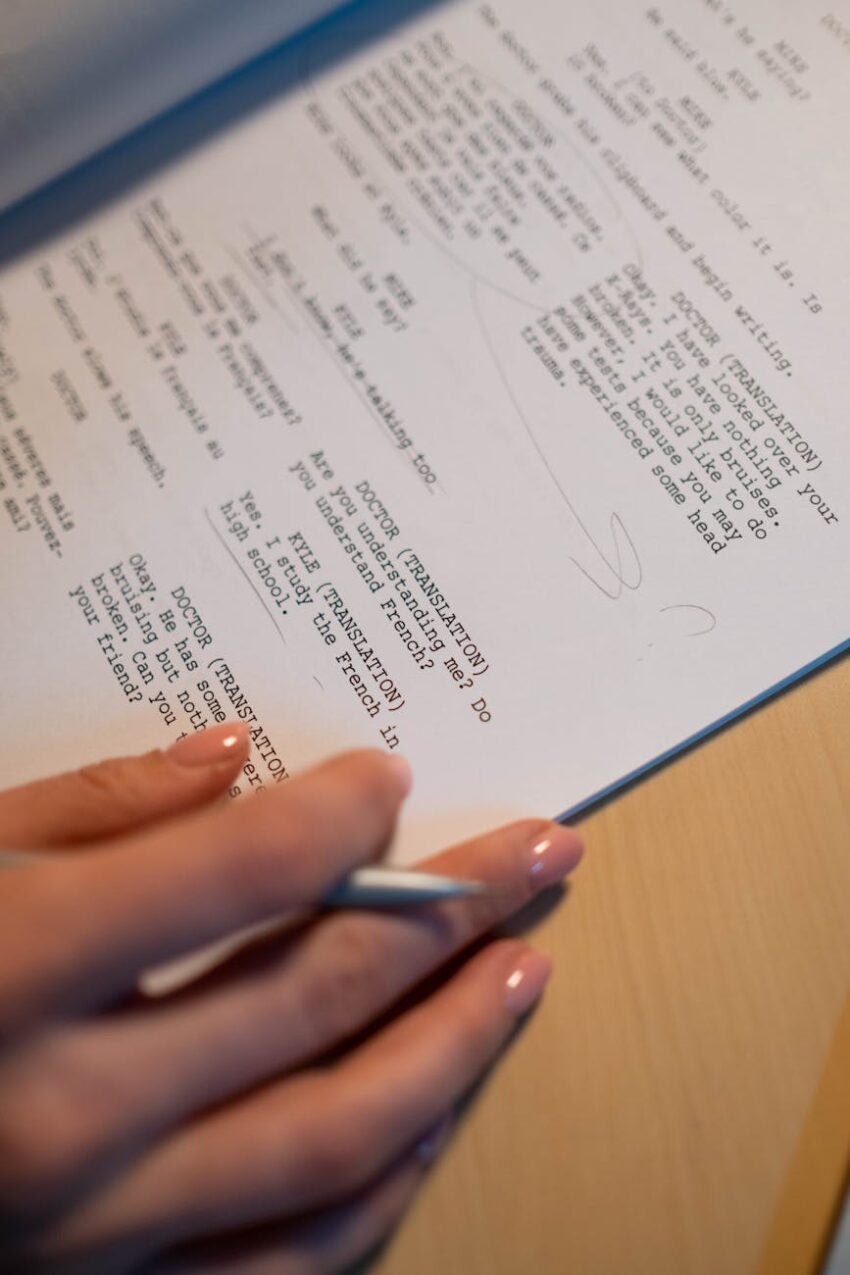Preparing to Revise
Time to bust out the red pen, because revision is where the magic happens! It’s your chance to polish what you’ve written, making sure it shines bright and clear. Prepping yourself properly for revision can do wonders for how your manuscript lands.
Embracing the Revision Process
First thing first: tackle revision with the right mindset. It ain’t something to dread; it’s more like a treasure hunt for all the hidden gems in your work. Keep this stuff in mind as you’re gearing up:
| Key Aspects | Insights |
|---|---|
| Mindset | Grow your mindset! Treat feedback like gold. It’s all about leveling up. |
| Patience | Revising needs some TLC. It could take a few rounds, and that’s okay. |
| Goal Setting | Aim small, miss small. Set targets that are do-able. |
Lean into the revision process and ease some of that anxious energy. Jump over to our other post on how to improve writing skills for extra tips.
Setting Aside Dedicated Time
Carving out revision time can really get the ball rolling. By setting up chunks of time where you zero in on revising, you’ll get stuff done with zero distractions. Check out these scheduling hacks:
| Time Block | Purpose |
|---|---|
| Daily Sessions | Spend a tight 30 to 60 minutes each day cleaning up your manuscript bit by bit. |
| Weekly Reviews | Reserve a big chunk of weekend time for heavy lifting and big changes. |
| Breaks | Little breaks here and there keep you sharp and help dodge burnouts. |
Stick to a schedule, and you’ll find your revision groove. Want more on creating good writing habits? Swing by our guide on how to develop a writing habit.
Take your revision prep seriously to power up your editing game. You’ll turn that rough draft into something that truly stands out!
Initial Read-Through
Alright, you’ve got your first draft done, and it’s time to give it a good, honest look. This phase is all about seeing if your story holds together like glue or needs some rework. You’re going to check the flow, find any sneaky plot hiccups, and smooth out any rough spots.
Assessing the Overall Structure
While you read through your draft, keep an eye on how everything fits together. Does that story of yours glide smoothly from start to finish? Here’s a quick checklist to guide you:
| Part of Story | What to Think About |
|---|---|
| Beginning | Does it grab people right away? Is it setting the stage? |
| Middle | Are things moving at the right pace? Any juicy conflicts to keep interest? |
| Ending | Does it wrap things up nicely? Are all loose ends tied? |
| Chapter Layout | Do chapters each have a point? Are the transitions silky smooth? |
It might help to imagine what others would critique. Check if your tale follows the basics of how to outline a story.
Identifying Plot Holes and Inconsistencies
Now, hunt down those pesky plot holes. You don’t want your readers scratching their heads in confusion. A checklist can work wonders in spotting these tricksters:
 What Poetry Feels Like
What Poetry Feels Like| Common Snags | What to Look For |
|---|---|
| Character Drives | Are your characters behaving true to their nature? |
| Timeline Check | Does everything happen in a logical order? |
| World Rules | Are the laws of your story’s universe consistent? |
| Character Growth | Do characters grow or evolve as the story unfolds? |
Investigating these areas will save you time in revisions later on. And, using helpful guides like how to improve writing skills can add an extra polish to your storytelling.
Focusing on the story’s structure and fixing plot problems does wonders in setting a sturdy base for future tweaks. Think of this step as building your book’s backbone before perfecting the details.
Fine-Tuning Characters and Dialogue
Getting those characters right, and nailing the dialogue makes readers want to dive into your story like it’s the last cozy blanket in a snowstorm. As you tweak your drafts, focus on these parts to give your tale that irresistible spark.
Developing Well-Rounded Characters
Characters can make or break your story’s grip. They need to feel like they’ve got lives of their own – hopes, pasts, little hiccups that keep them real and relatable. Here’s what to keep an eye on:
| Character Aspect | Description |
|---|---|
| Motivation | What gets your character out of bed in the morning? Clear goals make them pop. |
| Background | Their history and connections shape how they act. Give them roots! |
| Flaws | Perfect ain’t relatable. Give your folks quirks and hiccups. |
| Growth | Let them change as the story rolls on, so readers see them evolve. |
A character profile can be your sidekick in keeping all this straight. Need more? Dive into our piece on how to create realistic characters. Remember, throwing in some diverse characters adds layers to your tale, appealing to a bigger crowd.
Ensuring Authentic Dialogue
Good dialogue puts the sizzle into your story. It’s gotta sound believable and make each character’s voice stand out. Here’s how to keep your dialogue on point:
| Dialogue Element | Tips |
|---|---|
| Voice | Craft different speech styles based on their background or mood. Each should sound unique. |
| Realism | Speak it out loud. If it sounds odd, fix it till it doesn’t! |
| Subtext | Let them hint at things rather than spillin’ all secrets—keeps it spicy. |
| Pacing | Balance chat with action and scenery, so the story flows and doesn’t drag. |
Need more hints? Check out our guide on tips for writing dialogue. Make sure every chat has a point – whether it’s spotlighting who they are or giving the plot a nudge.
By honing in on these tips, you’re not just enhancing your narrative depth but also pulling your readers right into the mix with your story. Polishing your draft this way lets readers walk right into an experience they can’t forget.
Polishing Your Prose
Got your revision guide ready? It’s showtime for polishing up that text of yours. This step matters big time for sharpening the clarity and punch of what you’re writing. Zoom in on these two areas: tweaking language and style and getting rid of all that excess word baggage.
Refining Language and Style
A top-notch manuscript doesn’t just tell a tale, it pulls readers right in with snappy language and flair. Kick things off by giving your word choices the once-over. You want them to be as precise and colorful as possible. Strong verbs and exact nouns? They’re your new best pals—they’ll make your words pop.
Check out this little cheat sheet for jazzing up some common words:
| Old Word | Jazzed-Up Word |
|---|---|
| Said | Remarked |
| Walk | Strut |
| Happy | Elated |
| Big | Enormous |
| Look | Gaze |
Mix up your sentence structures to keep that rhythm going and hook your readers. Steer clear of sentences so tangled they’ll have your readers scratching their heads. Go for a blend of short and medium sentences for that perfect balance.
Curious about upping your writing game? Here’s a link you might wanna click—how to write better stories.
Eliminating Clutter and Redundancy
Putting your writing on a diet? Yep, the way to do it is by kicking out any words or phrases hogging space without adding anything valuable. A lot of writers sneak in words that sound nice but do zilch. Pull those out, and tada—you’ve got sleeker, more readable prose.
Here’s a quick list of flabby phrases and their fitter versions:
| Wordy Phrase | Slimmed-Down Version |
|---|---|
| In order to | To |
| Really | Very |
| Each and every | Each |
| Due to the fact that | Because |
| At this point in time | Now |
Once you spot those pesky redundancies, swap ’em with something tighter. This move doesn’t just make your piece clearer, it keeps readers locked in.
For more on sprucing up your editing mojo, take a gander at tips for editing your book. These tricks and tips can majorly polish your drafts, cranking up the ‘wow’ factor for whoever picks up your manuscript.
Checking Technical Elements
Once you’ve tinkered with your manuscript and polished the content, it’s time to zoom in on the nitty-gritty details. Those grammar and punctuation marks? They do a heck of a job in making sure your work isn’t just a bunch of words jammed together. Plus, keeping your point of view and tense straight sharpens the clarity and punch of your tale.
Grammar and Punctuation
Good grammar and punctuation are your bread and butter for getting your ideas across clearly. Mess those up, and readers can get lost or bored. Keep a lookout for common grammar blunders like whether your subjects and verbs are playing nice together and that you’re not chucking out sentence fragments willy-nilly. Here’s a quick rundown to help you stay on track:
| Common Grammar Snafus | What To Check |
|---|---|
| Subject-Verb Mismatch | Make sure subjects and verbs are on the same page in number. |
| Sentence Fragments | Avoid starting a thought and not finishing it. |
| Run-On Sentences | Don’t let sentences race on without proper punctuation breaks. |
| Verb Tense Mistakes | Stick with the same verb tense from start to finish. |
And hey, punctuation matters too! A wayward comma or quote mark can twist what you mean to say into something else. Give your manuscript a read aloud; you’d be surprised at what your ears can catch that your eyes boggled up.
If you’re feeling stuck, check out our handy articles: How to Write Better Stories and Tips for Editing Your Book.
Consistent Point of View and Tense
Keeping things consistent with your point of view (POV) and tense makes your story easy to follow. Flip-flop those, and folks might get a bit dizzy. Before wrapping up your manuscript, take a minute to check for any POV or tense hops.
Consider these main POVs:
| Point of View | What It’s About |
|---|---|
| First Person | The storyteller is in the story (I, we). |
| Second Person | The storyteller talks directly to you (you). |
| Third Person Limited | We get inside one character’s head (he, she). |
| Third Person Omniscient | We know what everyone is thinking and feeling. |
For keeping tenses straight, decide if you’re telling your story in the past, present, or future. Sketch out your narrative timeline if you need a hand-making sure it all flows evenly.
For more on crafting your cast of characters, slip over to our guide on Creating Realistic Characters. Or, if plotting’s your conundrum, peek at Crafting a Compelling Plot.
Taking the time to iron out grammar, punctuation, and consistency gives your manuscript that polished edge, making your story shine through and making the whole revision gig a lot smoother.
Seeking Feedback and Final Touches
You’ve put a lot into your manuscript. So before sending it off, getting outside opinions and making last-minute tweaks are key moves. Bringing in some beta readers or finding a solid critique partner can really help you polish your masterpiece.
Beta Readers and Critique Partners
Beta readers are folks who will read your draft before it hits the world. They give you a sense of how your tale hits with a fresh pair of eyes. Critique partners are the ones who point out the cracks and crevices of your work and suggest ways to make it better. Both are handy folks to have on your team.
When you’re on the lookout for these helpful types, here’s what you wanna think about:
| Criteria | Description |
|---|---|
| Genre Knowledge | They should know their stuff about your genre |
| Constructive Feedback | Able to dish out advice with a friendly touch |
| Availability | Ready to dive into your world and give their thoughts |
| Honest Opinions | Not afraid to tell you what’s what |
You can speed things up by asking them to focus on specifics, like story flow, the way characters come to life, or those snappy dialogues you’ve crafted. For even more pointers, check out our take on writing advice for new authors.
Making Final Revisions Before Submission
Now, you’ve got their feedback—it’s tweak-time! Breaking down their feedback into doable steps helps keep you on track. Jot down a simple list to make sure you’re hitting each target your beta readers or critique buddies mentioned.
| Task | Completed |
|---|---|
| Sort out major plot hiccups | [ ] |
| Beef up character stories | [ ] |
| Spiff up the dialogue for realness | [ ] |
| Nix grammar and punctuation slip-ups | [ ] |
Taking their thoughts seriously can do wonders for your draft. Last touches should cover grammar sweeps and keeping that tense and viewpoint steady. For more on sprucing up your book, hit up tips for editing your book.
Once you’ve worked through your tweaks, give your draft another read to make sure you’ve shined it up good and proper. If you’re struggling with sticking to your writing routine, see our piece on how to develop a writing habit.


 Grab my poetry book, 'we're all just wanderers in the end' Here
Grab my poetry book, 'we're all just wanderers in the end' Here AD: Your Book Finally Written...
AD: Your Book Finally Written...